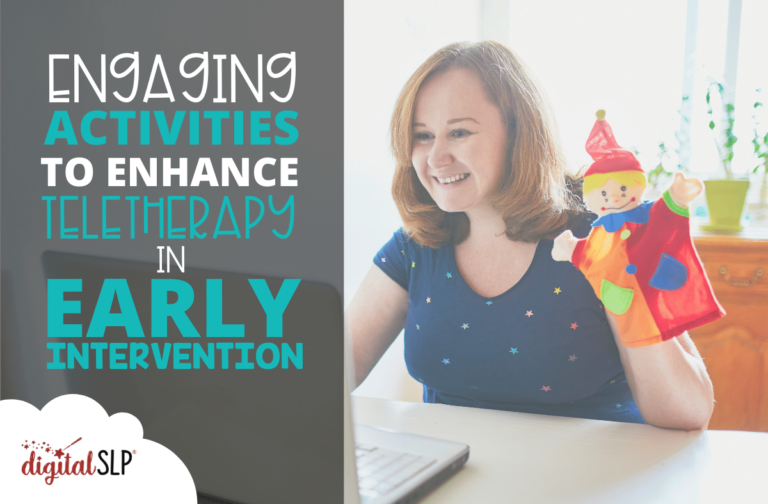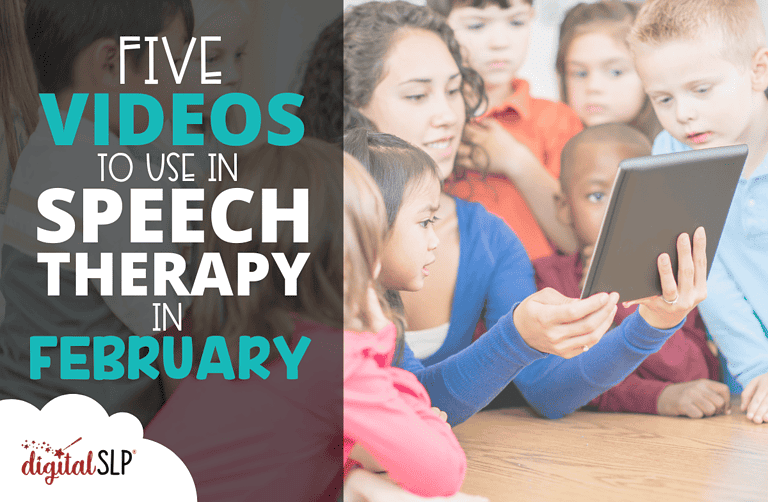Engaging Activities to Enhance Teletherapy in Early Intervention
1. Music:
Incorporating nursery rhymes, playing the child’s favorite songs, or bringing in musical instruments are just a few ideas of how to utilize music within early intervention teletherapy sessions. Try using the “waiting” strategy, singing a familiar song and waiting for the child to attempt to fill-in-the-blank. For example, you may begin singing “Old McDonald had a farm…..” and wait to see if the child attempts to say “E-I-E-I-O!”. Another strategy you may try is basic imitation with the use of instruments. Have the child imitate your actions, expose the child to novel verbs (i.e. “shake”, “bang”, “clap”, “tap”, etc.), and have parents work on turn-taking with the child to practice sharing of instruments.
2. Pretend Play:
Imitation of actions and sounds is a precursor to imitating words and is great for early intervention teletherapy activities:
- Try playing with a farmhouse and animals to work on imitation of animal sounds, actions, and exclamations (i.e. “uh oh!”, “woah!”). You can also work on making choices, having the child express the animal they want to play with (i.e. “Do you want cow or pig?”). Show the child how to engage in play, putting the animals to sleep, making the animals jump or run, feeding the animals breakfast, etc.
- Playing with a baby doll allows for many opportunities to build upon a child’s language! Have parents gather basic items (i.e. blanket, pretend food, utensils, brush, etc.) to use while engaging in pretend play. You can work on following directions, such as “give baby to daddy” or “give baby the bottle”, to work on receptive language skills. You can also work on understanding vocabulary, having the child identify vocabulary words including various foods, toys, or items. For example: “Give the baby a cookie” – have four or five different pretend food items and see if the child is able to identify the cookie.
- Using puppets in an early intervention teletherapy session is a MUST! Kids love puppets and there are so many different play ideas to incorporate during puppet play. Try feeding the puppet different food, working on imitating silly sounds. The puppet may spit the food out and yell “BLEH!” or the puppet may love the food and say “mmmm” or “yummy!” during the play interaction. Remember the waiting strategy? Have the puppet eat the food and wait to see if the child expresses “Bleh!” or “mmmm” to tell you what the puppet will do next!
3. Peek-A-Boo!
Are you working on the child saying “mama” or “dada”? Have the caregiver hide under the blanket! Model for the child, saying “Mama? Mama? Where is mama?”. Once the child shows any attempt at saying the caregiver’s name, have the caregiver immediately take the blanket off.
4. Balls/Vehicles:
- Stop/Go: Model for the child to either use the sign or verbally express “stop” and “go” to let you know when to let the ball/car go down the ramp! You can also use pull-back cars within your sessions – wait for the child to express “GO!” and then let the car zoom across the floor. Switch roles and have the child wait for you to say “GO!” and then the child, along with their caregiver’s assistance, can let the ball/car go.
- Up/Down: Visually showing the child the car/ball going up and down a ramp will support their understanding of the concept. Try encouraging the child to lift their arms up in order to express “up” if they are not yet verbally communicating. You can even have the child hold a ball/car themselves and have them make their ball go up and down to practice this concept.
- In/Out: Try creating a pretend garage and park the car “in” the garage and take it “out” of the garage. You can also work on understanding this concept while cleaning up – put the ball back “into” the bin or take it “out” of the bin.
- Fast/Slow: This concept is always a fun one to learn! Before incorporating the balls/cars, practice this concept by having the child show you fast and slow with their body! Once they understand how to move their body fast/slow, try the concept with the toys. Make the cars go super fast across the floor and then move the cars very slow. Take turns with the child to show fast/slow.
5. Books as a great source for early intervention teletherapy activities.
- Selecting books with repetition provides more predictable and rhythmic language. When working with children in early intervention, find books that have many repeated lines. You can use the “wait” technique here as well, reading the repetitive line in the book and pausing to allow the child to fill in the last word in the line. For example, while reading the book “Brown Bear, Brown Bear, What Do You See”, pause before you say the word “see” in order to allow the child to say the word.
- Provide a sensory experience within book reading by selecting lift the flap/touch feel books in order to create a more interactive experience! The child will show more engagement and participation when you make book reading more interactive. If the caregiver does not have a lift the flap book, that’s okay! You can still use your own and have the child make requests to “open” the flap (i.e. signing the word “open” or verbally expressing the request).
- Reading nursery rhyme books provide opportunities to use familiar and engaging songs that have pictures to match. These books allow caregivers to work on the fill-in-the-blank technique, pausing to allow the child to sing the missing word in the song (similar to the example above while reading “Brown Bear”). Nursery rhyme books also have rhymes incorporated throughout the book. Research says emphasis on rhyme has shown improved children’s understanding of rhymes as well as supports phonological awareness development. (Sim & Berthelsen, 2014). Try finding books with rhymes in order to support continued language growth and allow for increased exposure to rhymes.
Some research on book sharing and link to book suggestions:
- According to research, “Shared book reading involves a social and interactive context in which there is a transmission of literacy knowledge from the adult to the child.” Research states that the process of shared reading has shown improved language and literacy development as well as enhanced emotional attachment between parent and child. Children may develop early literacy skills even before formal education just by participating in shared reading and using various shared reading strategies (Sim & Berthelsen, 2014). Explain the importance of reading to caregivers and ensure the child is reading daily!
- Check out the previous blog post, “Great Books for Speech Therapy” for some suggestions of books you might select during therapy sessions!
6. Resources on The Digital SLP that are fun as early intervention teletherapy activities:
Sources:
1. (Sim & Berthelsen, 2014) Shared Book Reading by Parents with Young Children: Evidence-Based Practice













Recent Comments